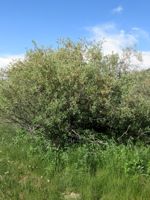Mon-Fri 9am - 5pm Mountain time
Bog Willow vs Diamond-Leaf Willow
Salix pedicellaris
Salix planifolia
CUSTOM GROW
CUSTOM GROW
One of the most common willows in Canada. This shrubby willow is common in swampy, peaty, shorelines (bogs and fens). Rarely over 6 feet in height.
A great native species for reclamation or naturalization projects in riparian zones.
All willow are important to native pollinators each spring as they have higher amounts of pollen and nectar early each growing season when other food sources are scarce.
Diamond-Leaf Willow is a native deciduous shrub known for its glossy diamond-shaped leaves, which give the shrub its name. Its catkins emerge in spring, providing an important early source of pollen for pollinators. The shrub’s dense growth also offers valuable cover and browse for wildlife, including moose and deer.
This shrub is well-suited to cool, moist habitats such as wetlands, streambanks, and forest openings. It spreads by rhizomes, helping to stabilize soils and form dense thickets. Diamond-Leaf Willow is valuable for reclamation, wetland enhancement, shelterbelt plantings, and a wide range of conservation and habitat restoration projects.

